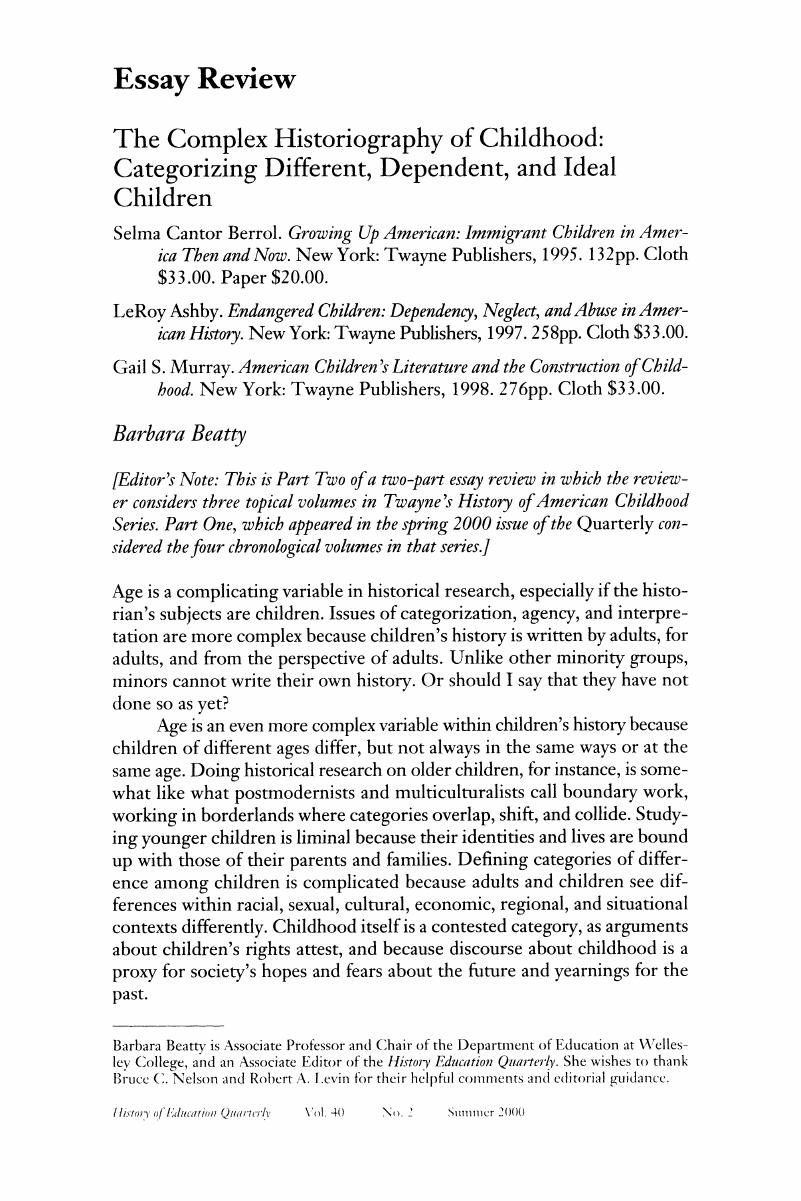Article contents
The Complex Historiography of Childhood: Categorizing Different, Dependent, and Ideal Children
Published online by Cambridge University Press: 24 February 2017
Abstract

- Type
- Essay Review
- Information
- Copyright
- Copyright © 2000 by the History of Education Society
References
1 Jones, Kathleen W. Taming the Troublesome Child: American Families, Child Guidance and the Limits of Psychiatric Authority (Cambridge: Harvard University Press, 1999).Google Scholar
2 Clement, Priscilla Ferguson Growing Pains: Children in the Industrial Age, 1850–1890 (New York: Twayne Publishers, 1998):74.Google Scholar
3 Percent calculated from graph “Vital Statistics,” U.S. Bureau of the Census Resident Population of the U.S.: Middle Series, U.S. Census Bureau Statistical Census Abstract of the United States (Washington, D.C.: United States Government Printing Office, 1998), 95.Google Scholar
4 See Polakow, Valerie The Erosion of Childhood (Chicago: University of Chicago Press, 1982); Postman, Neil The Disappearance of Childhood, (New York: Delacorte Press, 1982); Elkind, David The Hurried Child (Reading, MA: Addison-Wesley, 1981).Google Scholar
5 See Zelizer, Viviana Pricing the Priceless Child (New York: Basic Books, 1985).Google Scholar
6 National Center for Children in Poverty, Young Children in Poverty: A Statistical Update, March, 1998 Edition (New York: National Center for Children in Poverty, 1998).Google Scholar
7 Bradsher, Keith “Fear of Crime Trumps the Fear of Lost Youth,“ The New York Times, Sunday, November 21, 1999, Week in Review section, p. 3. Palmer, Louise D. “In court, youths losing their innocence,” The Boston Sunday Globe, January 24, 1999. p. 5.Google Scholar
8 Bradsher, “Fear of Crime,“ 3.Google Scholar
9 See Hymowitz, Kay Ready or Not: Why Treating Children as Small Adults Endangers Their Future and Ours (New York: Free Press, 1999).Google Scholar
10 Fass, Paula S. Kidnapped: Child Abduction in America (New York: Oxford University Press, 1997). For other views see Scott Heller, “The Meaning of Children Becomes a Focal Point for Scholars,” The Chronicle of Higher Education, August 7, 1998.Google Scholar
11 See Finkelstein, Barbara “A Crucible of Contradictions: Historical Roots of Violence against Children in the United States,“ History of Education Quarterly 40: 1. (2000): 1–21.CrossRefGoogle Scholar
12 See Gordon, Linda Heroes of their Own Lives: The Politics and History of Family Violence (New York: Viking, 1988).Google Scholar
13 MacLeod, David The Age of the Child: Children in America 1890–1920 (New York. Twayne Publishers, 1998), 152.Google Scholar
14 Hawes, Joseph M. Children Between the Wars: American Childhood, 1920–1940 (New York: Twayne Publishers, 1997); Beatty, Barbara Preschool Education in America (New Haven: Yale University Press, 1995).Google Scholar
15 Tobin, Joseph (ed.), Making a Place for Pleasure in Early Childhood Education (New Haven: Yale University Press, 1997).Google Scholar
16 For different views on children's literature see, among others, Bettelheim, Bruno The Uses of Enchantment (New York: Alfred Knopf, 1976); Lurie, Alison Don't Tell the Grown-Ups: Subversive Children's Literature (Boston: Little Brown Co., 1990); and Warner, Marina From the Beast to the Blonde: on Fairy Tales and their Tellers (New York: Farrar Straus and Giroux, 1995).Google Scholar
17 For an interesting reinterpretation of pre-Romantic children's literature see Norma Clarke, “‘The Cursed Barbauld Crew’: Women Writers and Writing for Children in the Late Eighteenth Century,” in Hilton, Mary Styles, Morag and Watson, Victor Opening the Nursery Door: Reading Writing and Childhood. 1600–1900 (New York: Routledge, 1997). 91–103.Google Scholar
18 Tompkins, Jane P. Sensational Designs: The Cultural Work of American Fiction, 1790–1860 (New York: Oxford University Press, 1985).Google Scholar
19 Halttunen, Karen Confidence Men and Painted Women: A Study of Middle-Class Culture in America, 1830–1870 (New Haven: Yale University Press, 1982).Google Scholar
20 Heller, “The Meaning of Children in Culture Becomes a Focal Point for Scholars.”Google Scholar
21 See David Tyack and Elisabeth Hansot, Learning Together: A History of Coeducation in America (New Haven: Yale University Press, 1990) and Tyack, David and Cuban, Larry Tinkering Toward Utopia (Cambridge, MA: Harvard University Press, 1995).Google Scholar
- 1
- Cited by




